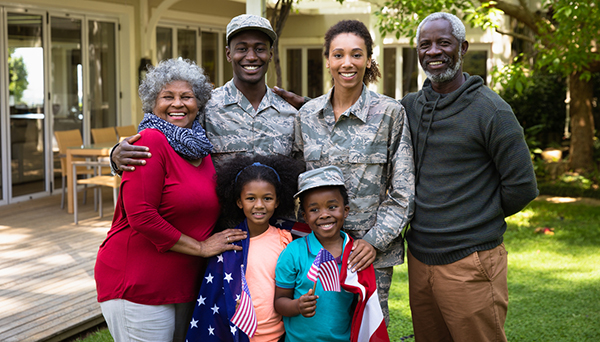Support Available for Veterans and their Caregivers

Veterans Day—originally known as Armistice Day—was first celebrated on November 11, 1919, to commemorate the end of World War I. It was officially recognized as a federal holiday in 1938 and was renamed Veterans Day in 1954 to honor all American veterans, both living and deceased.
We recognize those who have given so much for our freedom, including the ultimate sacrifice of their lives.
Let’s take a look at some of the statistics of two major wars:
- WWII—Of the 16.1 million Americans who served in World War II, 119,550 are still living, ranging from age 96 to 102.
- Vietnam War—As of 2023, for veterans serving from 1964–1975 approximately 850,000 are still living, ranging from age 61 to 103.
Though we know that many veterans suffer physical wounds, it is important to address their “invisible wounds.” The invisible wound is a cognitive, emotional, or behavioral condition that can be associated with trauma or serious life events. It may correspond with a diagnosis of major depressive disorder (MDD), post-traumatic stress disorder (PTSD) and/or traumatic brain injury (TBI).
What are the signs and symptoms of invisible wounds?
- Flashbacks
- Irritability, frustration anger
- Trouble with memory and attention
- Sensitivity to light and sound
- Headaches, migraines
- Constant negative tone
- Fatigue
- Poor self-care
- Anxious feelings
- Difficulty sleeping, issues of insomnia
- Feeling depressed
- Chronic pain
- Avoidance, detachment
Invisible wounds affect every aspect of a veteran’s life, and also impact family and loved ones. Examples include problems finding and maintaining affordable housing, coping with poverty, getting and holding onto a job, and living with substance abuse disorders. These are ongoing health issues that impact families and our community.
We encourage veterans and their families to reach out for support and assistance. United States Department of Veterans Affairs (VA) medical centers offer many important programs, including hospital services, primary and specialty care, mental health services, surgical services, medical specialties, rehabilitation care, geriatrics, and more. In the Seattle area, those services are available through VA Puget Sound Health Care.
If a veteran is enrolled in VA Healthcare, their family caregivers can check to see if they can participate in a program called Building Better Caregivers, an online program with six weekly self-paced lessons, facilitator guidance, group support, and access to an alumni community for program graduates, all designed to help caregivers of veterans living with dementia, memory problems, post-traumatic stress, or any other serious injury or illness. The caregiver must meet criteria and be willing to participate in the caregiver support program, either through the Program of Comprehensive Assistance for Family Caregivers or Program of General Caregiver Support Services.
As a volunteer facilitator for Building Better Caregivers, I can tell you that the stories and sharing are heartwarming and inspirational. Our veterans AND their loved ones and caregivers carry invisible wounds. The support that caregivers receive from other caregivers goes well beyond inspirational words. The ability to share anonymous struggles is key, and reading the heartfelt supportive messages that caregivers share with each other has proudly impacted me.
In caring for our veterans, we must also remember their caregivers. Let’s never forget to express our gratitude to both veterans and their loved ones for the gift of service.
 Contributor Mary Pat O’Leary, RN, BSN is a senior planner with Aging and Disability Services, the Area Agency on Aging for Seattle and King County.
Contributor Mary Pat O’Leary, RN, BSN is a senior planner with Aging and Disability Services, the Area Agency on Aging for Seattle and King County.
Photo credit: Wave Break Media
This article appeared in the November 2023 issue of AgeWise King County.
![Aging & Disability Services for Seattle & King County [logo]](https://www.agingkingcounty.org/wp-content/themes/sads/images/seattle-ads-logo.png)